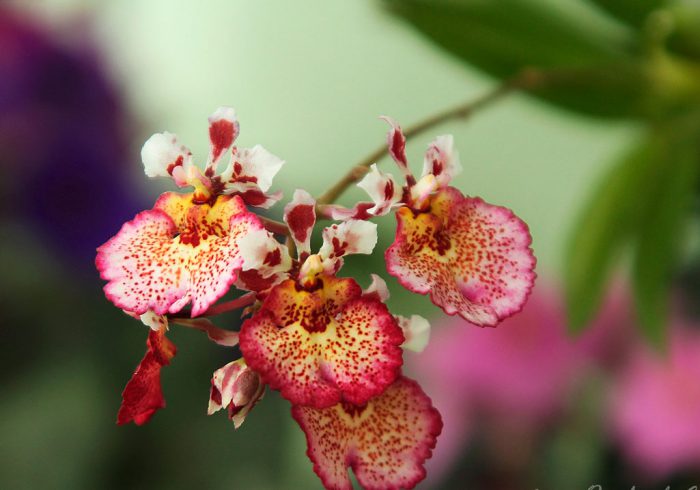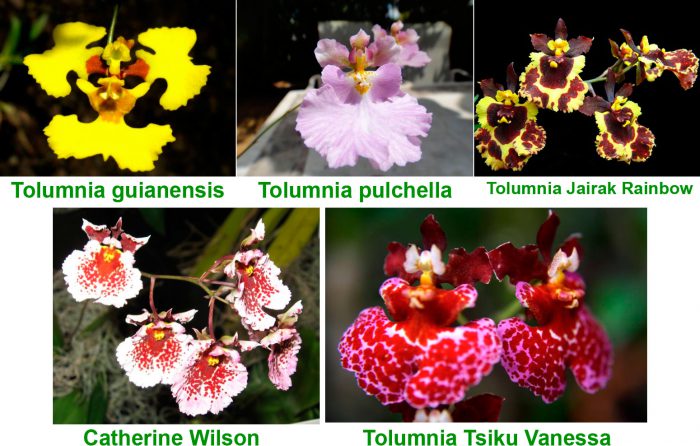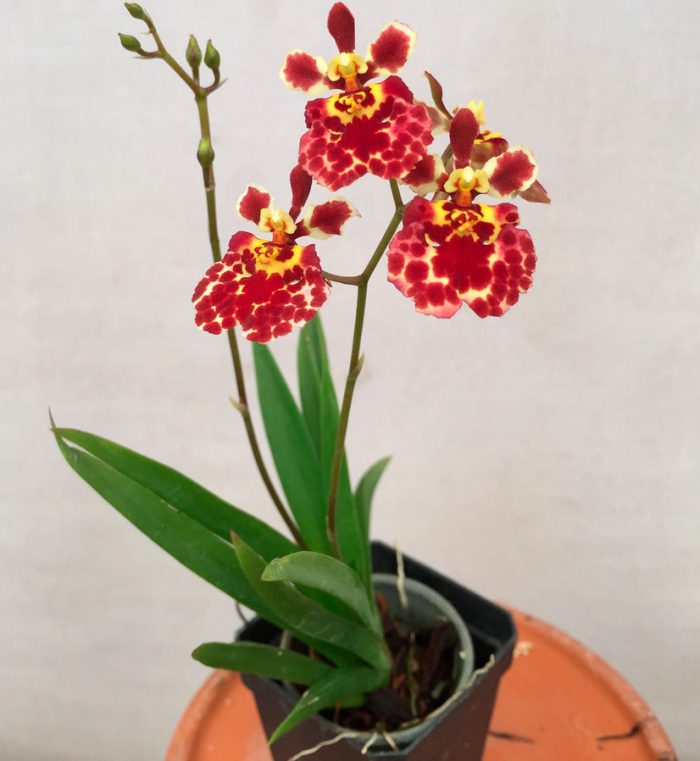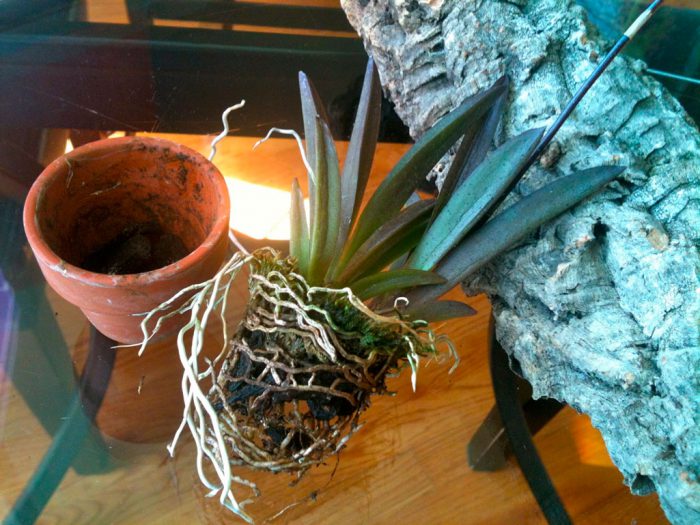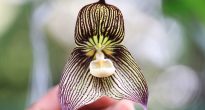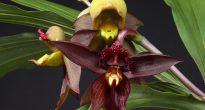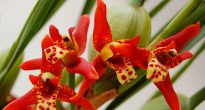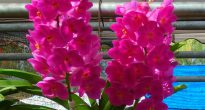A small genus of tolumnia (Tolumnia), belonging to the orchid family, has only recently been isolated from the larger genus Oncidium (Oncidium). This genus unites about 30 species of perennial plants. In nature, they can only be found on the islands of the Caribbean. To a large number of orchid growers, they are still known by their outdated generic name, and are sold in many flower shops.
Oncidium and tolumnia have clear differences, and therefore it is not so difficult to distinguish one plant from another. So, in tolumnia, unlike oncidium, there are no pseudobulbs at all, or they are weakly expressed. Often a short, thin stem grows in their place. Vaginal paired leaves grow on the rhizome (creeping shoot of sympoidal orchids), often in close contact with each other and forming medium-sized rosettes. The fleshy leaves can have a broad-lanceolate or oval-pointed shape, and they reach 5 to 20 centimeters in length and 5 to 15 centimeters in width. Long (up to 75 centimeters) branched peduncles are multi-flowered. Each inflorescence bears 12-60 small flowers, the diameter of which is 1.5-3 centimeters. The flowers are clearly zygomorphic and have a characteristic shape for oncidiums, but it is somewhat more complex. 3 narrow small sepals (sepals, which are confused with petals), wedge-shaped or obovate, fit into the apex of an isosceles triangle. 2 true petals (petals) are not as narrow as sepals, often wavy, sometimes have a jagged edge. The three-lobed compound lip (3rd petal) is divided into 2 equal parts, narrow at the base, it opens with a wide, rounded fan. The diameter of the lip, as a rule, is greater than the size of the entire flower, and sometimes it exceeds it by 2 or 3 times. A short, plump column (reproductive organ of a flower) has “winglets”.
Flowers can be painted in different colors, and they are also monochromatic or with a patterned pattern. For example, the pinkish-white calyx has many burgundy specks of various sizes and shapes. They can be located only in the center of the flower or be scattered over the entire surface of sepals and petals, changing their color to reddish-burgundy. Guiana Tolumnia (Tolumnia guianensis) - its flowers are painted in bright yellow color, while at the base of the petals there are small burgundy spots. Beautiful Tolumnia (Tolumnia pulchella) is a very beautiful plant with light pink flowers. At the base of the wide lip of such a flower, there are short yellowish strokes that create a torn chaotic pattern.
Many hybrids and varieties of such a plant have more bizarre and varied colors.The most popular is Tolumnia Jairak Rainbow. This spectacular hybrid is the result of crossing hybrids such as Tolumnia Catherine Wilson and Tolumnia Tsiku Vanessa. It has a rather complex color, formed by spots and strokes of white, burgundy, pink and yellow, while the combination and intensity of color shades directly depends on the variety. Thus, in the "Charming" variety, brownish-red sepals and petals have a whitish border; a pink-raspberry color has a lip closer to the edge, and in the center it is whitish-yellow with red spots, and they, merging at the base of the lip, create a uniform background of red color; there are reddish spots on the surface of the rich yellow column.
Content
Tolumnia orchid care at home
Tolumnia is suitable for home cultivation by experienced orchid growers, and for them it will not be difficult. Inexperienced growers, however, must make every effort to achieve the flowering of this plant.
Illumination
This light-loving plant needs bright enough light. The direct rays of the morning and evening sun do not harm this kind of orchid. But from the midday burning sun rays in the summer, she needs shading, because they can leave burns on the surface of the leaves. A window of western or eastern orientation is suitable for placing this plant. It should be remembered that from mid-autumn to mid-spring, the flower needs lighting with special phytolamps. Daylight hours all year round should have a duration of 10 to 12 hours, while the optimal illumination level should be at least 6000-8000 lux.
Temperature regime
The temperature regime for tolumnia is moderately warm, while the daily temperature drops should be well pronounced. The plant will grow and develop best at temperatures ranging from 18 to 22 degrees during the day and 14 to 16 degrees at night. Do not forget that the minimum difference in daily temperatures should be 5 degrees. Only in this case will the orchid bloom.
Earth mix
Such a flower is grown on blocks, in special hanging baskets, and also in pots. In this case, it is recommended to fill the pots with a mixture consisting of sphagnum and pieces of fine pine bark, they should be taken in a ratio of 1: 5. Blocks are made from large pieces of pine bark. On such a block, you need to fix the root system and rhizome of the plant, not forgetting to first cover them with a not very thick layer of sphagnum.
How to water
Watering is recommended only after the substrate is completely dry. Watering is best done by immersing the container or block in a bowl filled with water. You need to get the flower in 20-30 minutes. It is put in place only after the excess liquid has completely flowed out.
You need to water it with exceptionally well-settled and soft water. Orchidists with considerable experience advise that such water be heated to a temperature of 30 to 35 degrees, and at the same time the flower is best immersed in the liquid during watering as a whole (that is, the pot and the flower). It has been observed that a "hot shower" activates the growth of greenery and the formation of flower buds.
From the end of the autumn to the end of the winter period, this kind of orchid has a dormant period, while in their homeland at this very time there is a dry period. For this period, the plant needs to provide very poor watering. Tolumnia, which grows on a block, must be watered once every 14 days, and grown in a pot - once every 30 days. When the first flower stalks appear, the orchid is watered as usual.
If the plant does not have a dormant period, then flowering may not occur at all, or it will be very poor.
Humidity
Such a flower does not require too high humidity. So, it can grow and develop normally at a humidity of 45 to 70 percent. To increase humidity, household steam generators and humidifiers are used, as well as systematic moistening of foliage from a sprayer (this procedure should be carried out only in the morning). Also, an open vessel filled with water can be placed in the immediate vicinity of the flower. It is also recommended to pour expanded clay into the pallet and pour in a little water.
Transplant features
It is necessary to transplant tolumnia only if absolutely necessary:
- the block or container has become cramped for the flower;
- the substrate is sour or decomposes, algae have appeared on its surface.
Fertilizer
For feeding, special complex fertilizers for orchids are used, while the dosage must be seen on the package. You need to feed the flower every 5 waterings.
Reproduction methods
To propagate a plant in an apartment environment, you can only divide the rhizome. It should be remembered that the cut will grow and develop better if it has at least 3 pairs of leaves.
In industrial conditions, propagated by meristem (cloning) and by seeds.
Diseases and pests
The flower is resistant to pests. He can get sick as a result of overflow (especially when kept cool). In this case, he develops root rot.
Advice
This plant blooms for 2–3 months. However, after flowering is over, peduncles should not be removed. The fact is that such old flower stalks are distinguished by repeated flowering, so young branches are formed over time. Experts advise to remove only those parts that dry up.

